Attached files
| file | filename |
|---|---|
| 8-K - FORM 8-K - PERDOCEO EDUCATION Corp | d8k.htm |
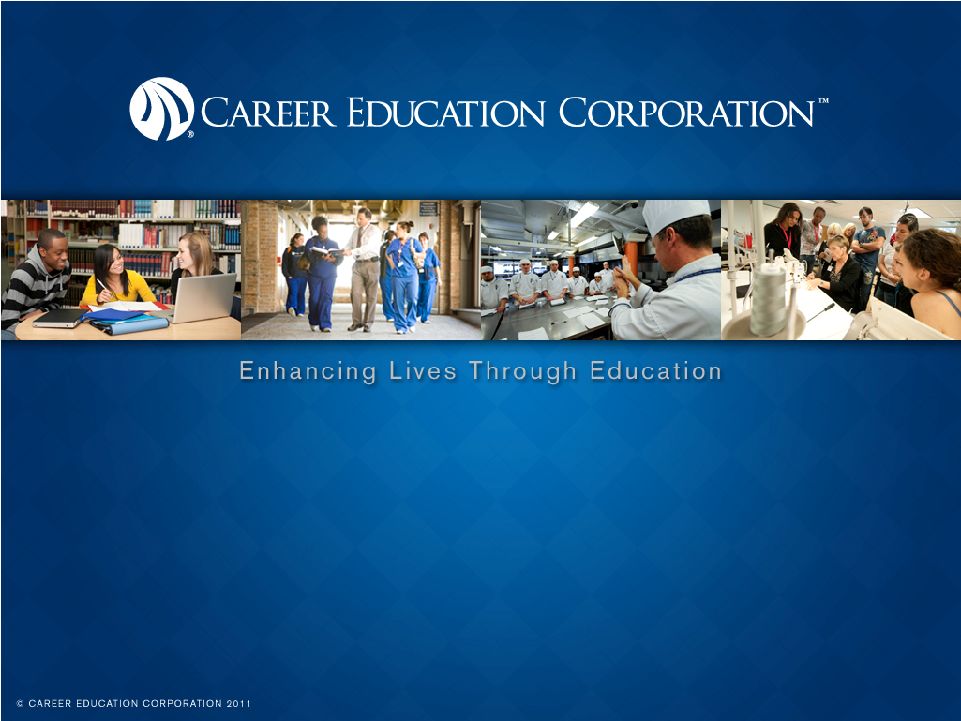 Barclays Capital
Global Services Conference
May 12, 2011
Exhibit 99.1 |
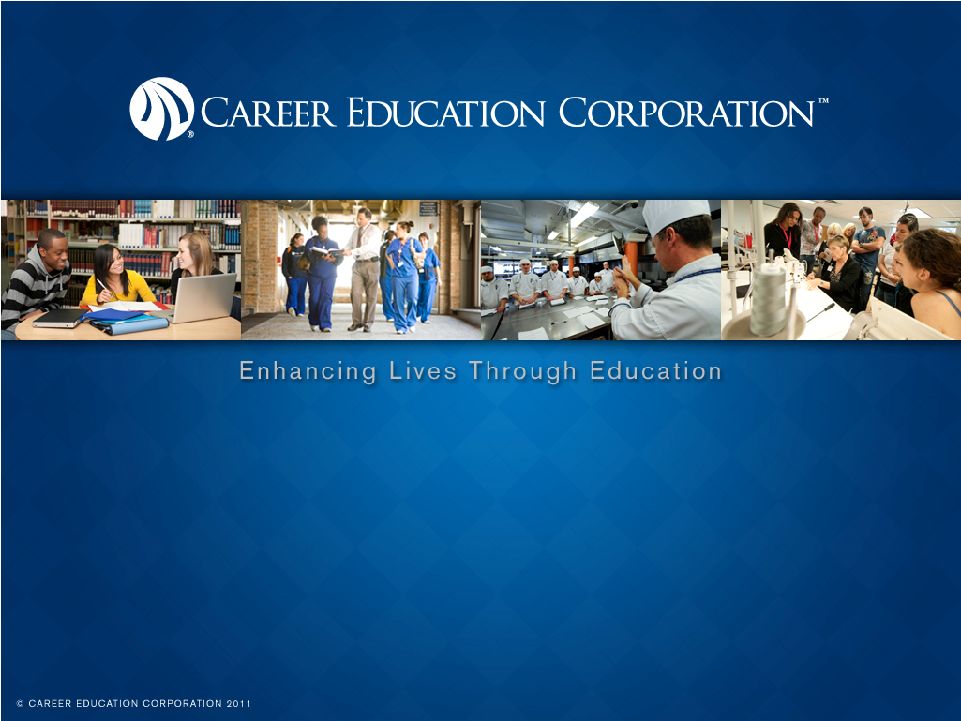 Gary
E. McCullough President and Chief Executive Officer
|
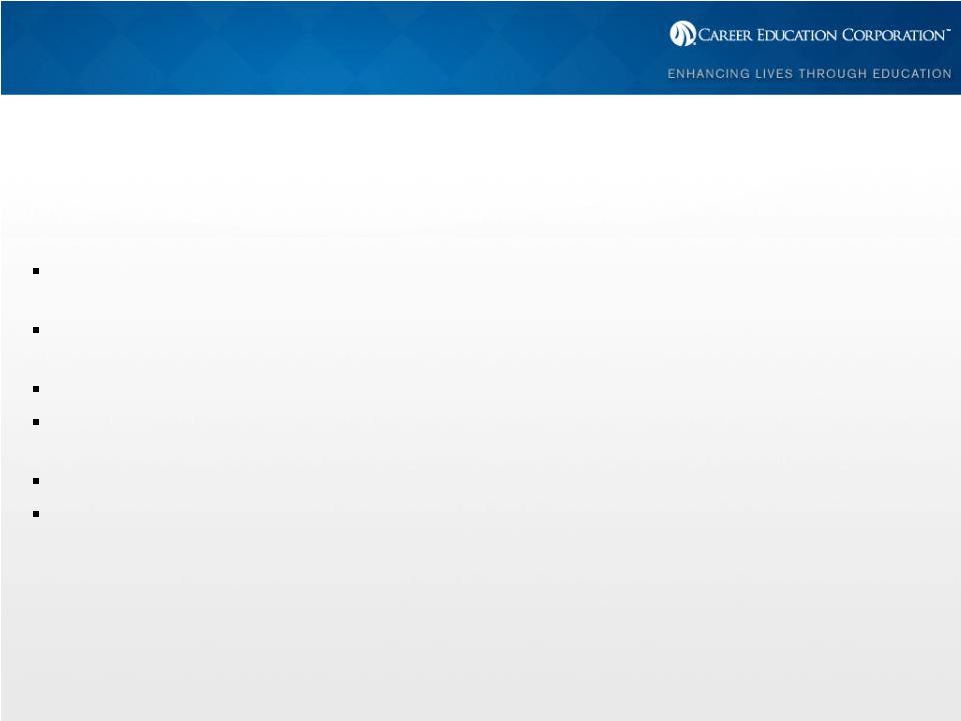 Safe
Harbor During this presentation, we will make forward-looking statements
subject to known and unknown risks and uncertainties that could cause actual
performance to differ materially from that expressed or implied by the
statements. These statements are based on information currently
available to us. Some factors that could cause actual results and
performance to differ are:
Our ability to comply with the extensive regulatory requirements and accreditation
requirements for school operations
Changes and uncertainties in student lending markets and federal and state student
financial aid programs
Financial and operating results, including new student starts
Our ability to manage and grow our business in current and changing economic,
political, regulatory and competitive environments
Litigation,
claims
and
administrative
proceedings
involving
the
company
Other risks described from time to time in our press releases and our filings with
the Securities and Exchange Commission
We undertake no obligation to publicly release any revisions to forward-looking
statements to reflect events or expectations after the date of this
presentation. We provide a detailed discussion of risk factors in our
SEC filings and encourage you to review the filings. |
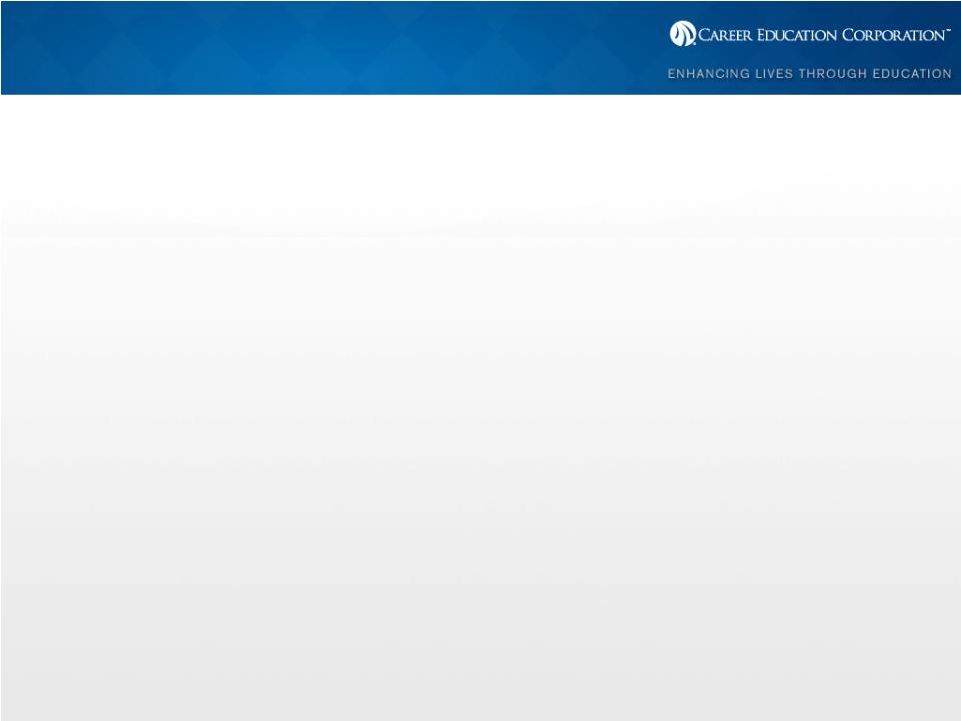 The
Company has included some non-GAAP financial measures in this presentation to discuss the
Company's financial results and outlook. As a general matter, the Company
uses these non-GAAP measures in addition to and in conjunction with
results presented in accordance with GAAP. Among other things, the Company
may use such non-GAAP financial measures in addition to and in conjunction with corresponding
GAAP measures, to help analyze the performance of its core business, in connection
with the preparation of annual budgets, and in measuring performance for
some forms of compensation. In addition, the Company believes that
non-GAAP financial measures are used by analysts and others in the investment community to
analyze the Company's historical results and in providing estimates of future
performance and that failure to report these non-GAAP measures could
result in confusion among analysts and others and a misplaced perception
that the Company's results have underperformed or exceeded expectations.
These non-GAAP financial measures reflect an additional way of viewing aspects
of the Company's operations that, when viewed with the GAAP results and the
reconciliations to corresponding GAAP financial measures, provide
a
more
complete
understanding
of
the
Company's
results
of
operations
and
the
factors
and trends affecting the Company's business. However, these non-GAAP measures
should be considered as a supplement to, and not as a substitute for, or
superior to, the corresponding measures calculated in accordance with
GAAP. Non-GAAP Financial Measures |
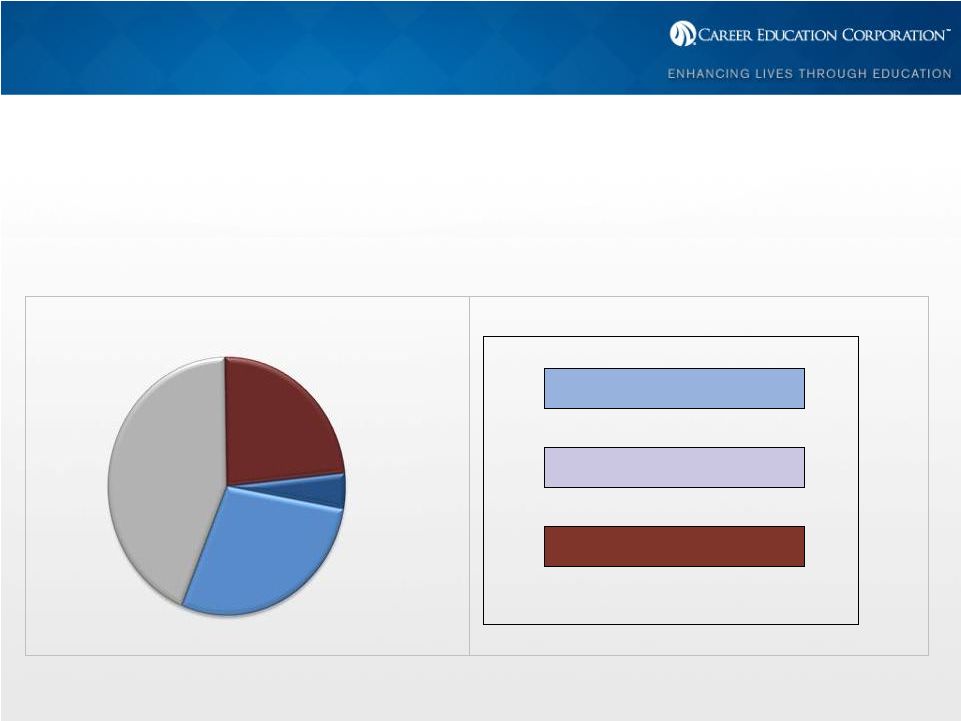 Career Education Overview
Purpose:
To
enhance
lives
through
education
Purpose:
To
enhance
lives
through
education
Over 119,000 Students
Over 500,000 Graduates
21 to 30
43%
Under 21
15%
Over 30
42%
Students by Age
Bachelors
32%
Masters
7%
Certificate
22%
Associates
39%
Students by Degree Type
Note: Demographics and student population data as of March 31, 2011.
|
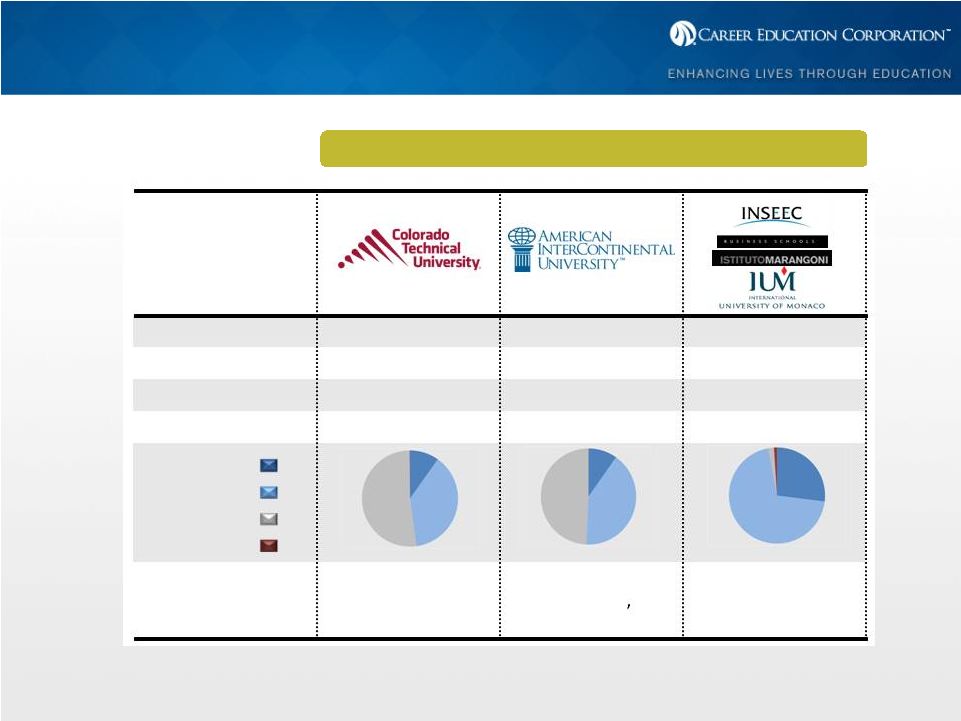 University
Career Education: Diversified Portfolio
Note: Demographics and student population data as of March 31, 2011.
Population
29,100
22,500
10,800
% Online
82%
83%
N/A
# of Campuses
5
5
13
Accreditation
Regional
Regional
Various European
Program Emphasis
Business, IT,
Health,
Protective Services
Business, IT
Education
Protective Services
Business, Design
Bachelors
Masters
Certificate
Associates |
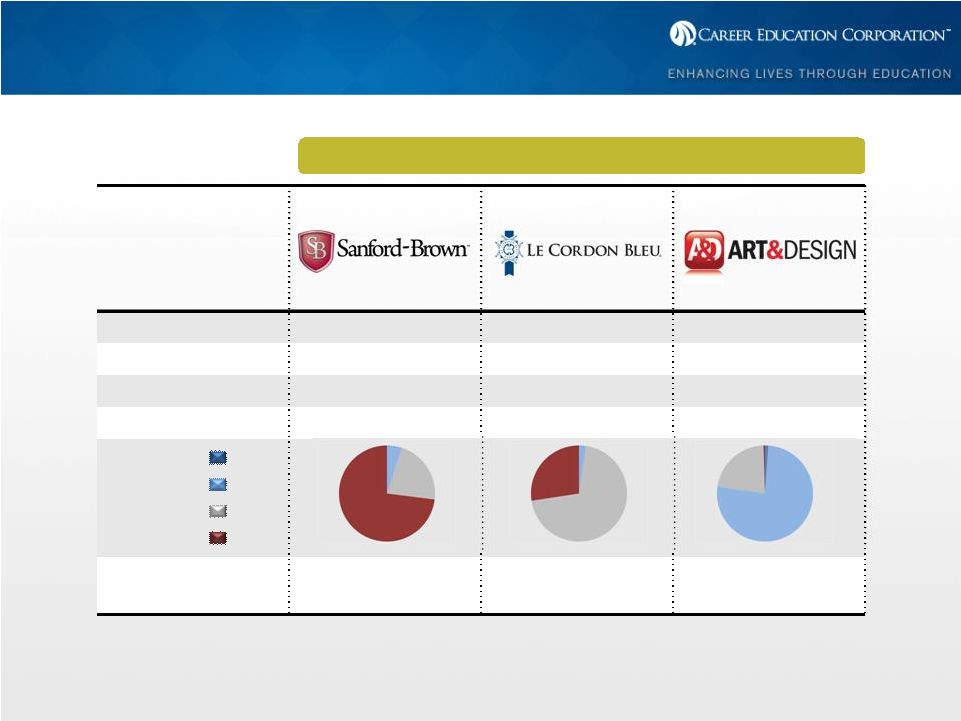 Career Education: Diversified Portfolio
Population
31,300
13,500
11,900
% Online
<1%
3%
18%
# of Campuses
39
18
14
Accreditation
National
National
National
Program Emphasis
Health
Culinary
Design, Photography
Bachelors
Masters
Certificate
Associates
Career-Focused
Note: Demographics and student population data as of March 31, 2011.
|
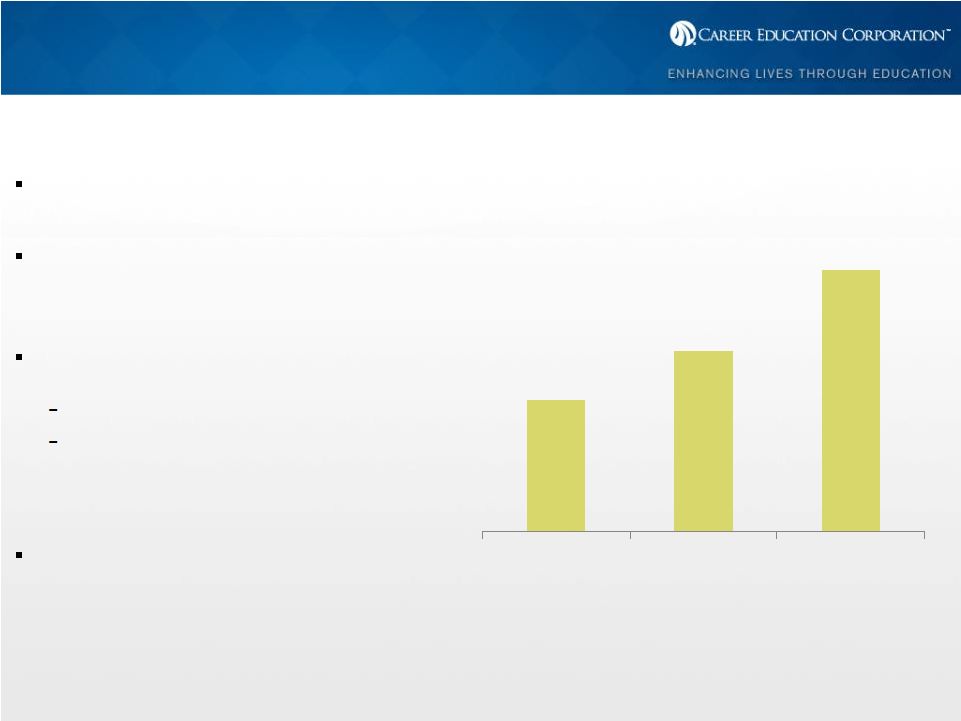 2008
– 2010: Key Accomplishments
Grew Revenue 28%
Increased Student Population 19% from
98,000 to nearly 117,000
Expanded Operating Margins 820 basis
points to 17.1%
EPS growth of 142%
Cumulative Free Cash Flow of
approximately $500M since 2008
(2)
Transformed Company Culture and
Values
Revenue Trend ($B) &
Adjusted Margin (%)
(1)
$1.66
$1.83
$2.12
2008
2009
2010
8.9%
14.1%
17.1%
(1)Adjusted
margins
are
based
on
continuing
operations
and
exclude
significant
items
as
noted
in
“Appendix
--
GAAP
to
Non
GAAP
Reconciliation”.
(2)“Free
Cash
Flow”
is
defined
as
cash
flows
from
operating
activities
less
capital
expenditures. |
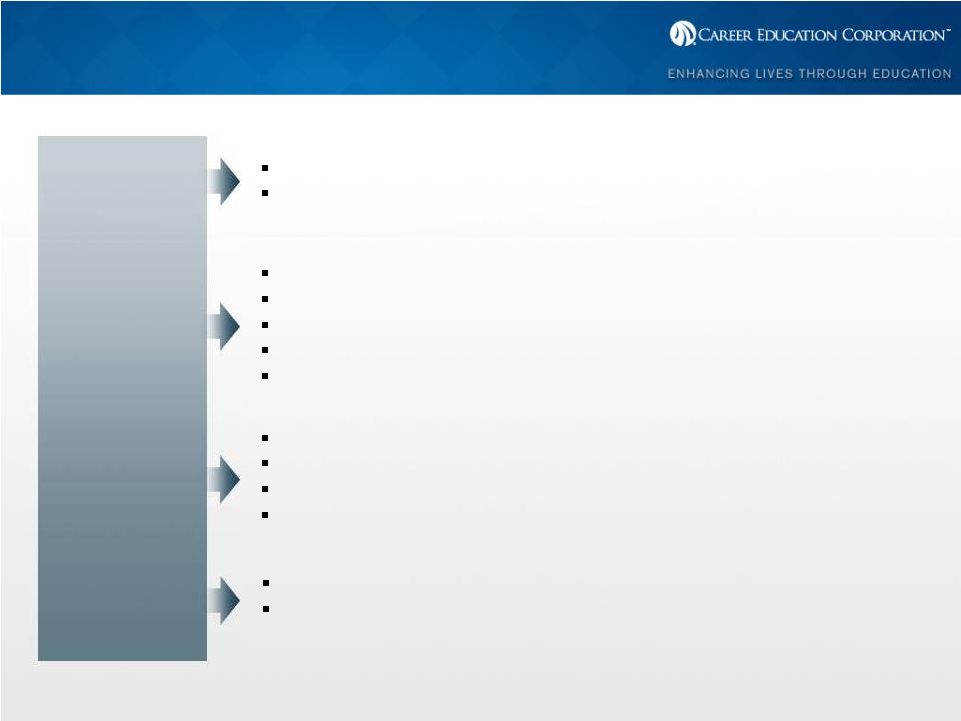 LTM
Highlights Ending March 31, 2011 Grew Student Population to approximately
119,000 Opened four Allied Health schools
Improved operating margins 390 bps to 20.8% in Q1 2011
Generated approximately $147M of free cash flow
Repurchased 6.1M shares of stock totaling $155M
Completed build out of Campus Support Center
Continued shared services expansion
Completed teach-outs announced in 2008
Aligned workforce in response to market dynamics
$399M cash and short-term investments
No debt
Focus on
Student
Success
Growth with
Disciplined
Investment
Operational
Effectiveness
Strong
Balance
Sheet
Increased Career Services personnel by 14%; Academics by 12%
2010 placement rates in line with 2009 |
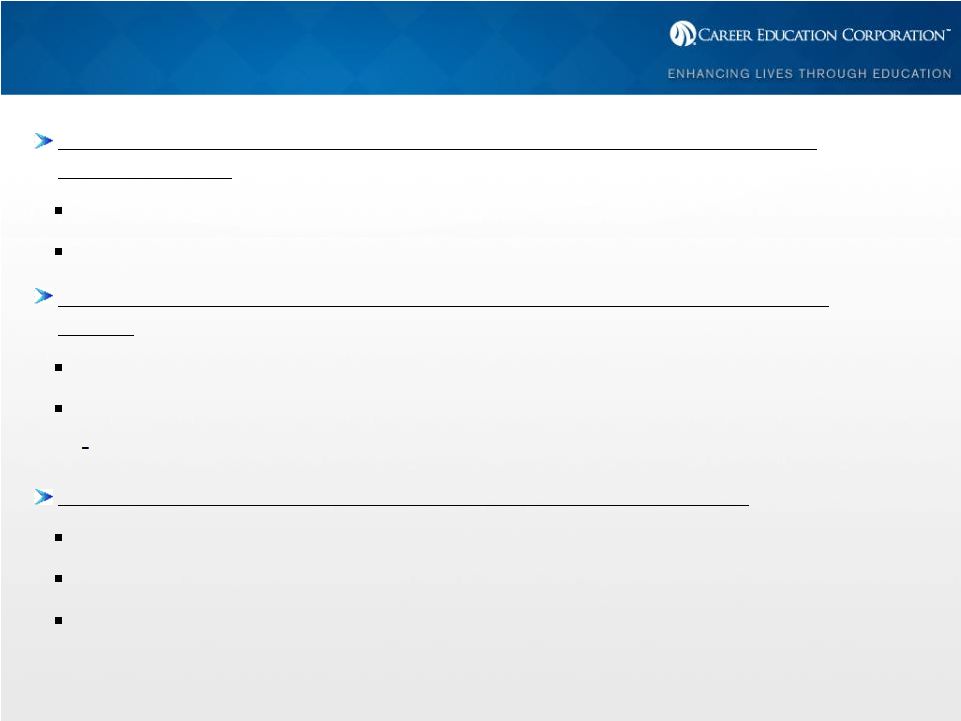 Regulatory Environment
Remain hopeful the Department will make constructive changes to
proposed rules
Overwhelming response to the DoE on Gainful Employment
Await details of new rule pending recent submission and review by OMB
Conflicting rules which require institutions to “thread the eye of the
needle”
Gainful Employment: Encourages reduction in tuition
90/10: Encourages higher tuition levels to avoid penalty
Exacerbated
by
reclassification
of
2008
Stafford
loan
increases
from
“10”
to
“90”
Rules will likely result in unintended negative consequences
Disproportionate impact on schools with diverse student population/ open
enrollment Retroactive application
Institutions are unable to limit student borrowing levels to cost of
education |
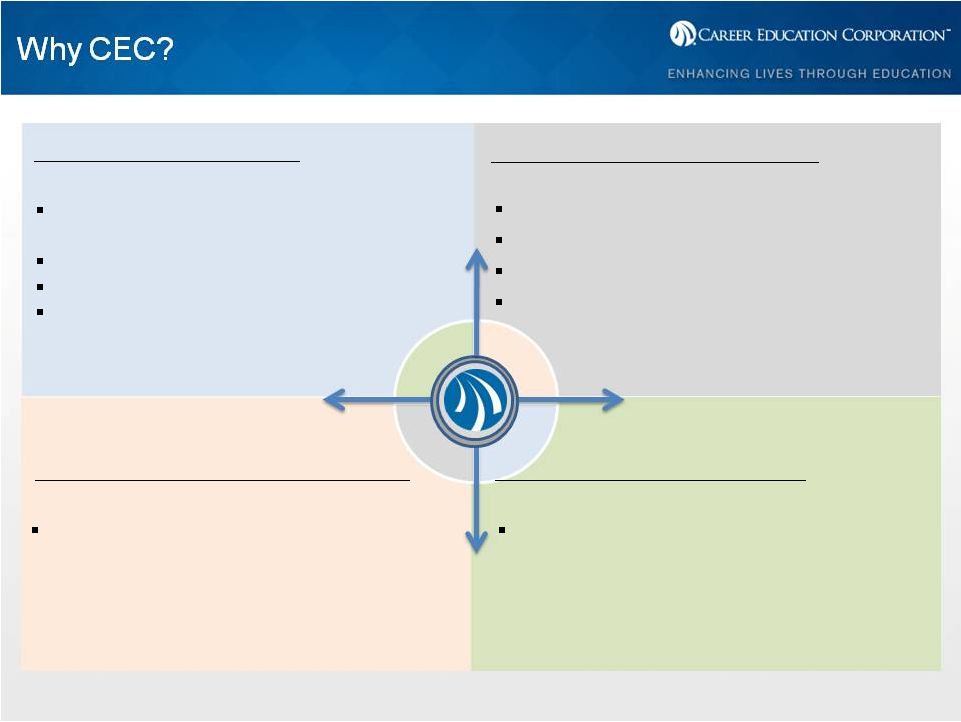 Why
CEC? Diversified Model
Disciplined Approach
Respond to all Challenges
-
Private Lending Market
-
Negotiated Rulemaking
-
Gainful Employment
University, Health Education, Culinary Arts,
Art & Design
Focus on programs with strong outcomes
Strong European platform
Online education remains fastest growing
segment in Education Market
Financial Resources
Strong balance sheet
-
$399M cash/no debt
-
2010 free cash flow of $145M
“Build”
versus “Buy”
for expansion
Select strategic M&A
Shared Services/ proactive cost management
Returned ~$370M to shareholders through
share repurchase in last 3 years
Agile Management Team |
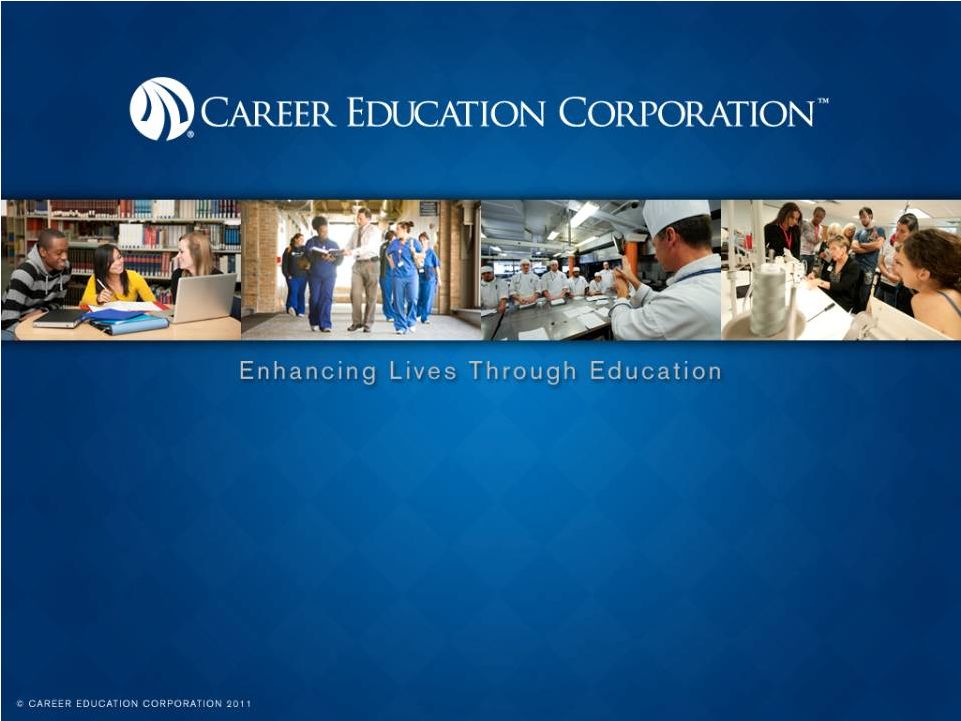 Mike Graham
EVP & Chief Financial Officer |
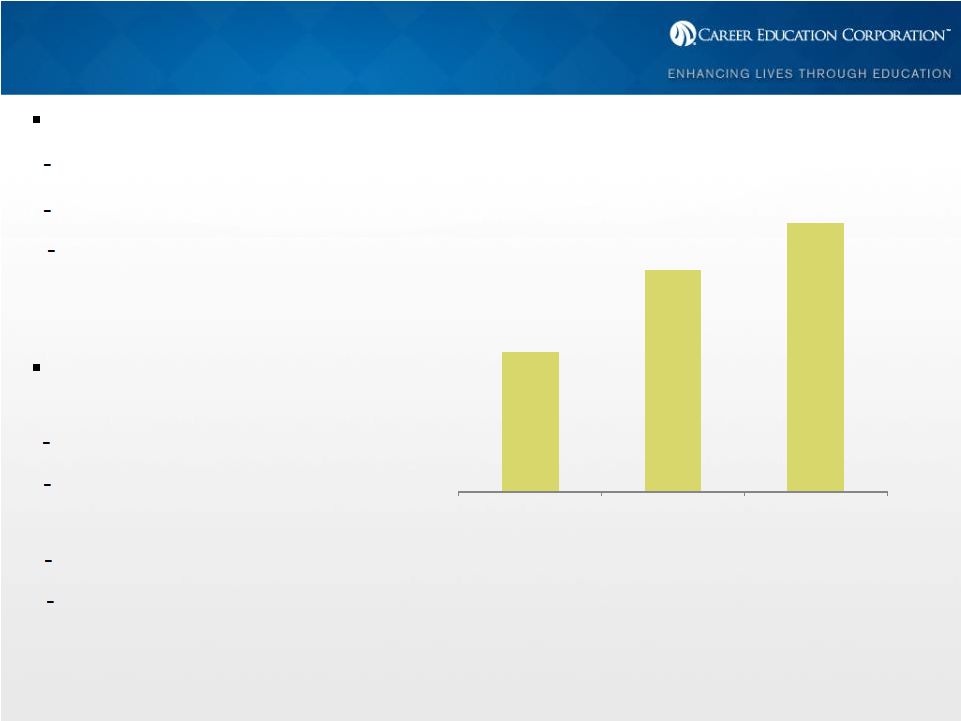 Operating Margin
Disciplined Approach
Health Start-Ups
M&A
Increase in Career Services &
Academics
Responsive to Market
Conditions
Shared Services
Fixed & Metric based
Reductions
Modified Culinary Model
Ended Extended Student
Payment Programs for New
Students
Adjusted Operating Income
(Margin %)
(1)
8.9%
14.1%
17.1%
2008
2009
2010
+520 bps
+300 bps
(1) Adjusted operating income is based on continuing operations and excludes significant items as
noted in “Appendix -- GAAP to Non GAAP Reconciliation”. |
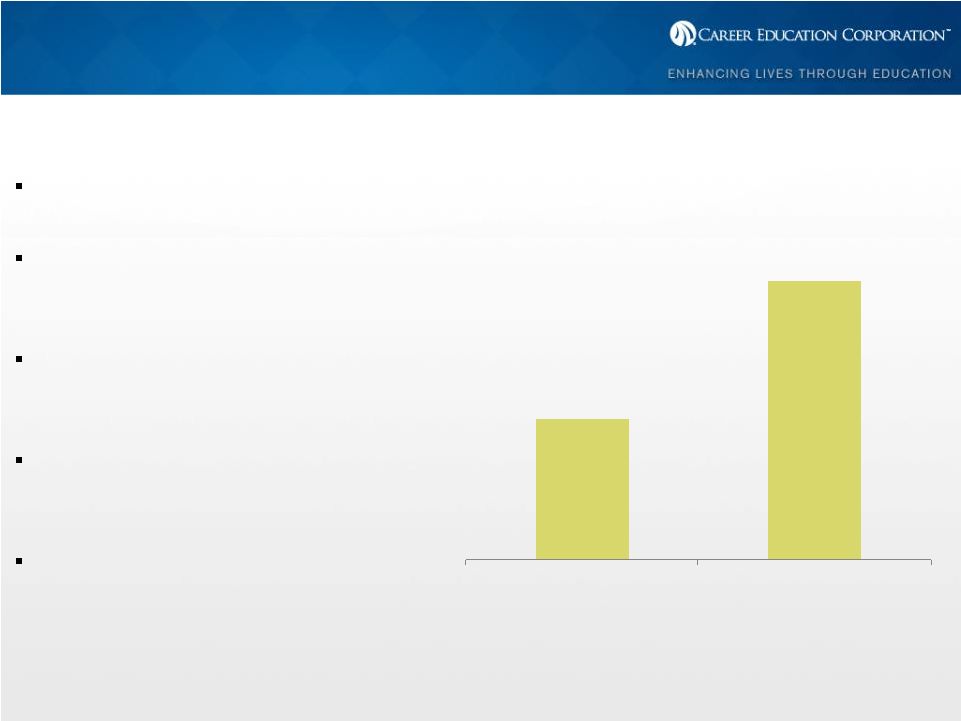 Q1
2011 Performance Grew Revenue by 3%
Operating income of $113M, up 27%
versus Q1 2010
Operating profit margin of 20.8%, 390
basis points above last year
Student Population of approximately
119,000
Earnings Per Share increased 44%
Revenue ($M) & EPS
Growth (YoY)
$529
$543
Q1 2010
Q1 2011
16.9%
20.8% |
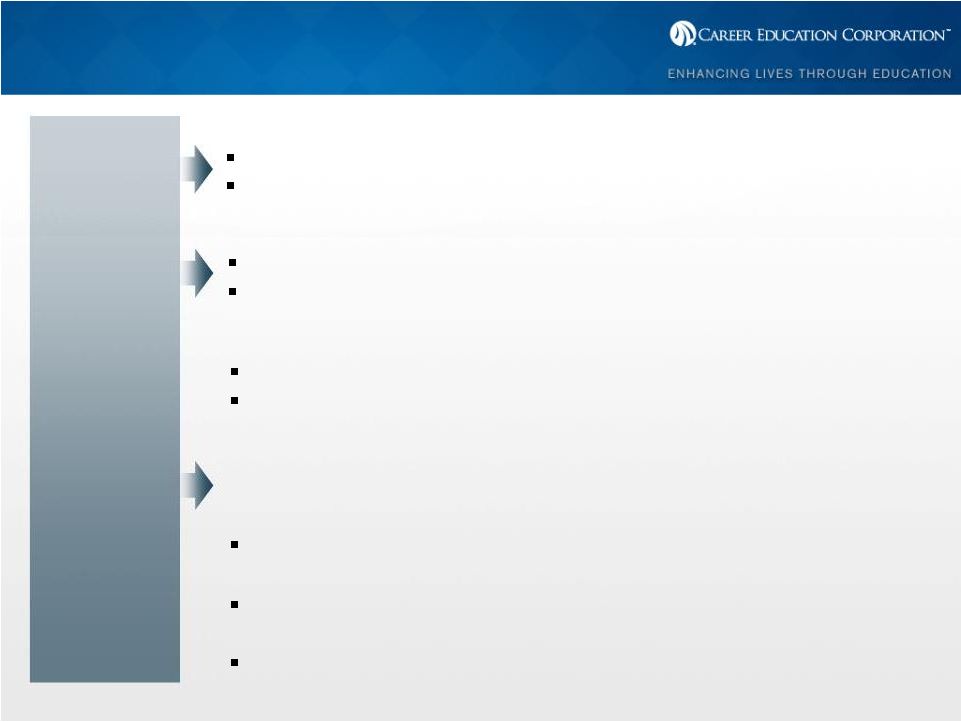 Culinary Model
2010
Highlights
More
Sustainable
Positioning
Key
Changes
Grew student population by 20%
Increased adjusted operating margin by 560 basis points to
11.5%
Leverage strong kitchen curriculum
Competitive tuition between higher priced institutions and tax
payer subsidized community colleges
Ended student payment plan for incoming Culinary students
12 month certificate program with tuition of approximately
$17,500
–
Emphasis
on
practical
hands-on
kitchen
skills
–
Shift
of
focus
from
Associate
degree
to
Certificate
–
Average
education
cost
reduction
of
50%
Emphasis on 450 critical cooking competencies, less on
General Education subjects
Will continue Associate degrees in Chicago and Pasadena and
online Bachelors degree program
Teach out LCB Pittsburgh |
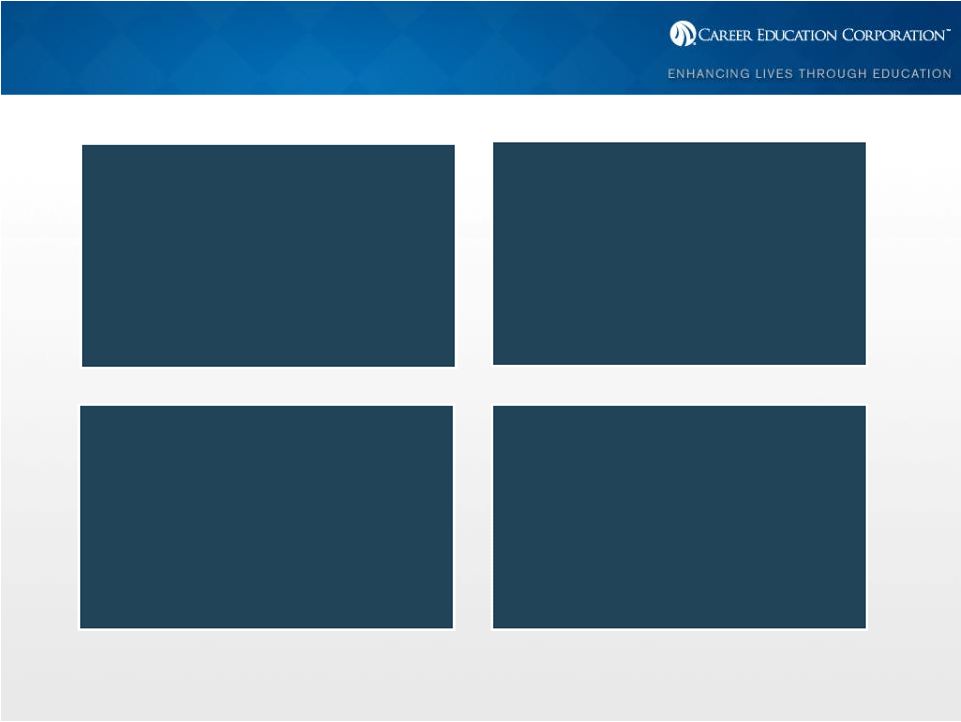 Uses of Cash
Share Repurchase
•
Remain Committed to Returning Cash to
Shareholders
•
As of May 6, 2011, $201M
authorization remaining
High ROI Strategic Investments
•
High Return Projects
•
Health Education Start Ups
•
Completion of Chicago-area Real Estate
optimization
•
Critical Student Services –
Faculty,
Career Services, IT Systems
Strong Balance Sheet
•
Maintain appropriate ED ratios
•
Limited Future Receivable Growth
from Extended Payment Plans
•
Disciplined Capital Expenditures
M&A
•
Potential for accretive tuck-in
acquisitions across University, Career
Focused and International
•
New Locations
•
New Programs Areas
•
Build versus Buy Mindset |
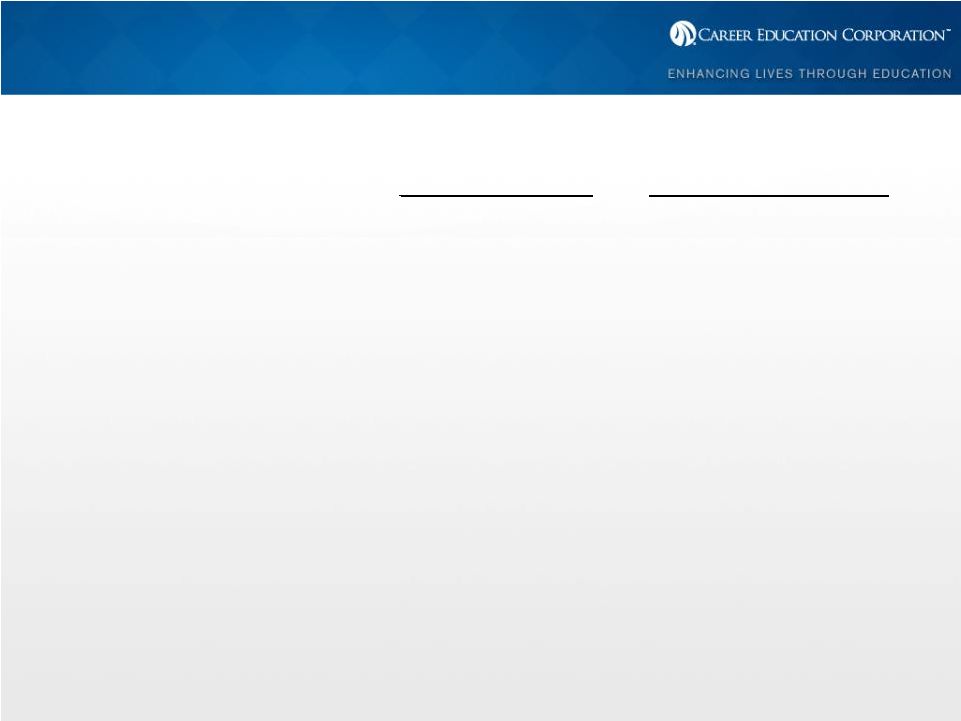 2011 Milestones
2010 Results
2011 Milestones
Revenue ($B)
$2.12
(2% -
5%)
Operating Income ($M)
$363
Operating Margin:
GAAP %
11.6%
Normalized %
17.1%
14% -
16% |
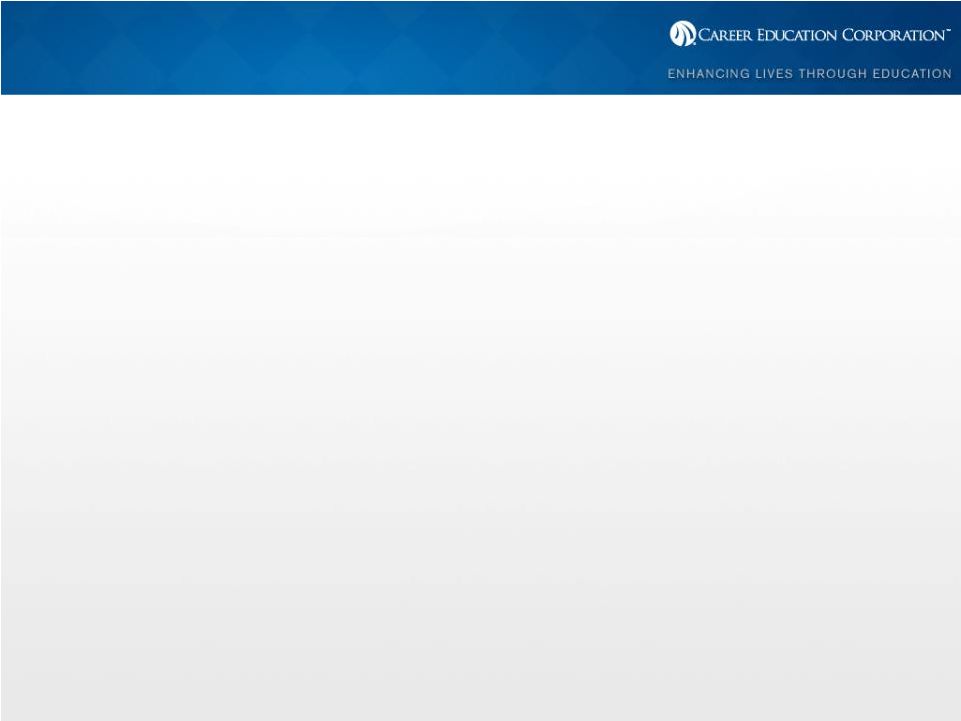 QUESTIONS? |
 Footnotes:
(1)The Company believes it is useful to present non-GAAP financial measures
which exclude certain significant items as a means to understand the performance of its core business. As
a
general
matter,
the
Company
uses
non-GAAP
financial
measures
in
conjunction
with
results
presented
in
accordance with GAAP to
help
analyze
the
performance
of
its
core
business,
assist with preparing the annual operating plan, and measure performance for some
forms of compensation. In addition, the Company believes that non-GAAP financial information is
used by analysts and others in the investment community to analyze the Company's
historical results and to provide estimates of future performance and that failure to report non-GAAP
measures could result in a misplaced perception that the Company's results have
underperformed or exceeded expectations. Non-GAAP financial measures when viewed in a
reconciliation to corresponding GAAP financial measures, provides an additional way
of viewing the Company's results of operations and the factors and trends affecting the Company's
business.
Non-GAAP
financial
measures
should
be
considered
as
a
supplement
to,
and not as a substitute for, or superior to, the corresponding financial results
presented in accordance with GAAP.
(2)Earnings per share based on continuing operations.
(3)Fourth quarter 2010 includes a $67.8 million pretax trade name impairment within
Culinary Arts. The $2.5 million asset impairment in 2009 resulted from the carrying value exceeding
the fair value for one of our owned facilities. In 2008, we recorded $6.8
million in asset impairment charges related to the reduction in asset carrying value for one of our leased facilities
within Culinary Arts and the write off of a trade name within Health
Education. Unaudited
Reconciliation
of
GAAP
to
Non-GAAP
Items
(1)
(In millions, except per share amounts)
2008
2009
2010
Operating
Earnings per
Operating
Earnings per
Operating
Earnings per
Income
Diluted Share
(2)
Income
Diluted Share
(2)
Income
Diluted Share
(2)
As Reported
$114.8
$1.04
$229.0
$1.73
$246.4
$2.06
Reconciling Items:
Asset Impairment
(3)
6.8
0.05
2.5
0.02
67.8
0.55
Legal Settlement
(4)
6.3
0.05
-
-
40.8
0.33
Severance & Stay
6.6
0.05
1.5
0.01
7.7
0.06
Remaining Lease Obligations for Vacated Space
11.6
0.08
14.3
0.11
-
-
Performance-based Compensation Related to Plan
Outperformance
(5)
-
-
23.1
0.17
-
-
Termination of Insurance Policies
(6)
-
-
(12.0)
(0.09)
-
-
Gain from Termination of Affiliate Relationship
(7)
-
(0.03)
-
-
-
-
Adjusted to Exclude Significant Items
$146.1
$1.24
$258.4
$1.95
$362.7
$3.00
Diluted Weighted Average Shares Outstanding
90,089
86,418
80,850
Appendix: GAAP to NON GAAP |
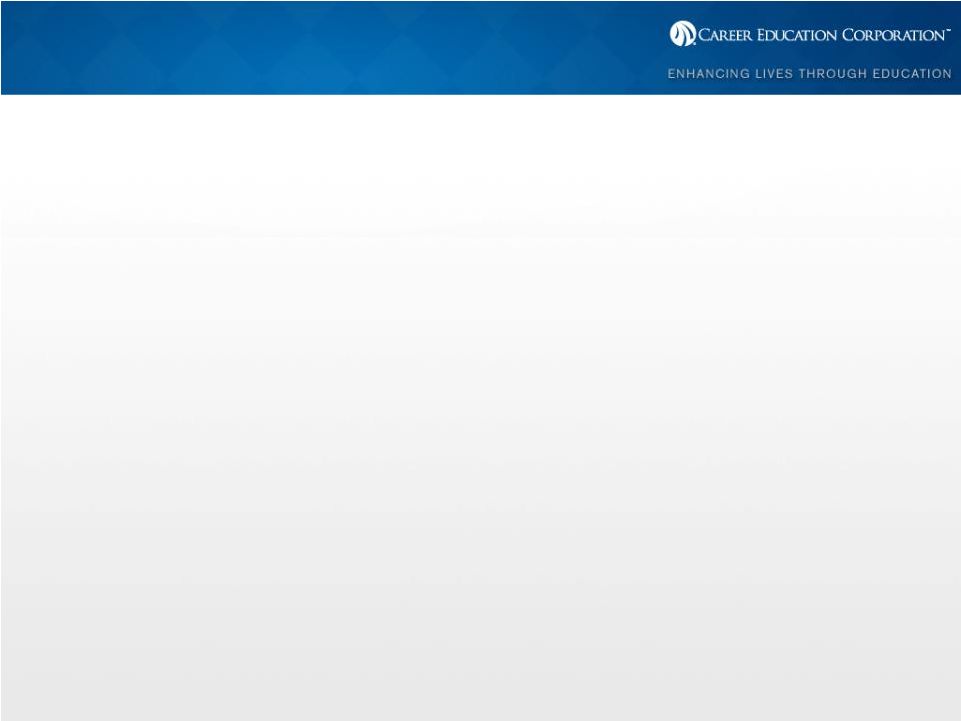 Appendix: GAAP to NON GAAP
Footnotes:
(4)A $40.8 million charge was recorded in 2010 and $6.3 million, net in 2008
related to the settlements of legal matters within Culinary Arts and Health Education.
(5)The
2009
performance-based
compensation
related
to
plan
outperformance
by
segment
was:
Corporate
-
$11.3,
Health
Education
-
$4.3,
Culinary
Arts
-
$2.1
million,
Colorado
Technical University -
$1.9, American Intercontinental University -
$1.8, and Art & Design -
$1.7.
(6)A $12.0 million payment was received in the fourth quarter 2009 related to the
termination of certain insurance policies. (7)Gain from Termination of
Affiliate Relationship is recorded within other income on the consolidated statement of operations. |
